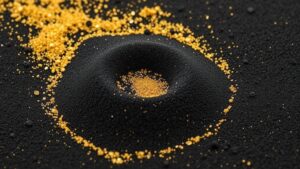Identifying Carbonate Veins Associated With Hydrothermal Silver Deposits
Identifying Carbonate Veins Associated With Hydrothermal Silver Deposits
The identification of carbonate veins in the context of hydrothermal silver deposits is crucial for the exploration and extraction of silver, a metal of significant economic value. Hydrothermal processes involve the circulation of mineral-rich hot water which can precipitate various minerals, including carbonates. This article discusses the characteristics, formation, and identification of carbonate veins, while providing examples to illustrate their significance in silver mining.
Understanding Hydrothermal Processes
Hydrothermal processes refer to the movement of heated water in the Earths crust, leading to the deposition of minerals. In this context, the composition and temperature of the hydrothermal fluid play critical roles in the types of minerals that precipitate. Silver is often found in association with these processes, particularly in veins where carbonate minerals are prevalent.
As hydrothermal fluids ascend through the Earth, they can dissolve various elements, including silver, copper, lead, and zinc. When the solution cools or undergoes changes in pressure, the dissolved minerals precipitate as solid phases, forming veins. dominant minerals found in these veins can vary widely, but carbonates are often prominent.
Characteristics of Carbonate Veins
Carbonate veins, primarily composed of minerals such as calcite (CaCO3), dolomite (CaMg(CO3)2), and ankerite (CaFe(CO3)2), are identifiable through various physical and chemical characteristics:
- Color and Texture: Carbonate minerals can exhibit a range of colors, typically white to gray, and often display a crystalline texture.
- Association with Other Minerals: Carbonate veins are frequently found in conjunction with sulfides and quartz, indicating a specific geological environment.
- Reaction to Acid: A defining characteristic of carbonate minerals is their reaction to dilute hydrochloric acid, which results in effervescence due to the release of carbon dioxide gas.
Formation Mechanisms of Carbonate Veins
Several mechanisms contribute to the formation of carbonate veins associated with hydrothermal silver deposits:
- Temperature and Pressure Changes: As hydrothermal fluids move upwards, a decline in temperature and pressure can lead to the precipitation of carbonate minerals.
- Pore Fluid Composition: The chemical composition of the fluid, particularly the concentration of carbon dioxide and calcium, influences which carbonate minerals will form.
- Biological Activity: Organic processes may also play a role; for instance, microbial activity can induce conditions that promote carbonate precipitation.
Identification Techniques
Identifying carbonate veins in the field involves several techniques leveraging both geological and geochemical datasets:
- Geological Mapping: Detailed mapping of geological formations can help locate potential carbonate vein deposits.
- Geochemical Analysis: Samples taken from suspected veins can be analyzed to determine their mineral composition, often through techniques such as X-ray diffraction (XRD) or scanning electron microscopy (SEM).
- Field Tests: Simple field tests, such as acid tests, can provide quick on-site verification of carbonate presence.
Case Studies of Silver Deposits with Carbonate Veins
Real-world examples of hydrothermal silver deposits associated with carbonate veins can be observed in notable mining regions:
- Fresnillo District, Mexico: This region is renowned for its rich silver deposits and features prominent carbonate veins, contributing significantly to its silver production.
- Sierra Nevada, California: Historical mining activities in this area unveiled numerous carbonate veins loaded with silver-bearing minerals, aiding the gold rush during the 19th century.
Conclusion
Identifying carbonate veins associated with hydrothermal silver deposits is essential for effective mining strategies and economic exploitation of silver resources. By understanding the geological conditions that favor carbonate formation, utilizing appropriate identification techniques, and learning from past case studies, geologists and miners can effectively locate and extract these valuable minerals. Ongoing research and technological advancement will further enhance our ability to discover and harness these resources sustainably.
Actionable Takeaways
For professionals in the field, it is advisable to:
- Enhance geological mapping techniques to accurately locate potential carbonate vein deposits.
- Use comprehensive geochemical analysis as a routine part of exploration efforts.
- Foster interdisciplinary collaboration, integrating biological and geological sciences to better understand carbonate formation mechanisms.

